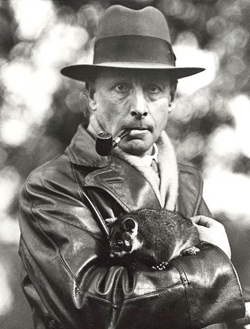
Council of Heads of Australasian Herbaria
Australian National Herbarium
Biographical Notes
 |
Council of Heads of Australasian Herbaria |
 Wood-Jones, Frederic (1879 - 1954)
Wood-Jones, Frederic (1879 - 1954)(also as JONES, Frederic Wood)
Born on 23 January 1879 at Hackney, England, UK; died on 29 September 1954, London, UK.
His father was a builder but died young and "Freddy" was brought up by his mother, whom he resembled in vivid good looks and alert mentality.
He was educated at the London Hospital, qualifying in 1904.
He devoted himself to anatomy.
From June 1905 to September 1906 he served as medical officer at the cable station on the Cocos Keeling Islands in the Indian Ocean.
There he met his future wife, Gertrude daughter of George Clunies-Ross the Governor of the Islands.
After a brief period in England at the London Hospital Medical College he was married, and went to Egypt to assist in exploring ancient Nubian cemeteries; the report of the expedition made great additions to knowledge in palaeopathology and physical anthropology.
During 1908-12 he worked in England, in the Anatomy department at St Thomas's Hospital and at Manchester University.
He took the DSc in 1910 and was appointed the first Professor of Anatomy at the School of Medicine for Women (Royal Free Hospital) London in 1912. He held this post till 1919.
For much of 1914-18 war he was working in the RAMC at the Special Military Surgical Hospital at Shepherd's Bush.
He was elected in 1919 to the Elder chair of Anatomy at Adelaide University, and spent eighteen years in Australia.
University of Adelaide 1920-1930, then University of Melbourne 1930-1938.
In South Australia Jones was a keen participant in the activities of the Anthropological Society of South Australia and, with Draper Campbell and John Cleland, urged the University of Adelaide to found the Board of Anthropological Research.
During 1932-33 he went on leave from Melbourne to be Director of the American sponsored Peiping University Medical College in China.
He came back to England in 1938 as Professor of Anatomy at Manchester.
When he retired in 1945, he was invited to fill the chair of Comparative and Human Anatomy at the College, with the Conservatorship of the Hunterian Museum, the intention being that he should restore the war-damaged Museum, which he successfully achieved.
He retired from the Professorship in 1951 but continued as Honorary Conservator.
Frederick Wood Jones was unorthodox in many ways, provocative, stimulating and courting of controversy. He was one of the greatest science communicators of his time with 15 books and over 300 published articles.
Most of his herbarium specimens are collected as "Wood-Jones, F." only three are labelled "Jones, F.W.".
Source: Extracted from:
https://www.eoas.info/biogs/P000912b.htm
https://livesonline.rcseng.ac.uk/client/en_GB/lives/search/detailnonmodal/ent:$002f$002fSD_ASSET$002f0$002fSD_ASSET:377690/one?qu=%22rcs%3A+E005507%22&rt=false%7C%7C%7CIDENTIFIER%7C%7C%7CResource+Identifier
https://racp.intersearch.com.au/shows3item.php?file=blogposts%2F22-7_Wood_Jones.html
Portrait Photo: University of Melbourne, Medical History Museum, MHM2014.152.
Data from 27 specimens
